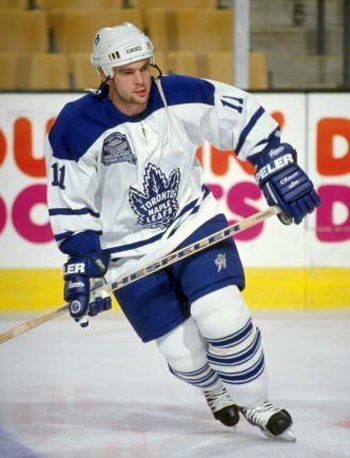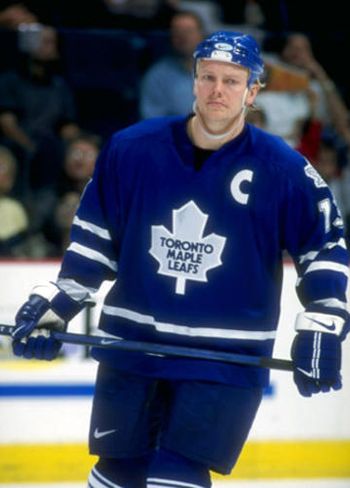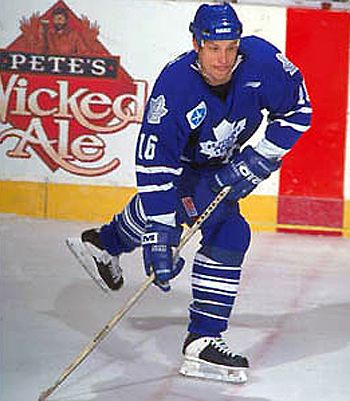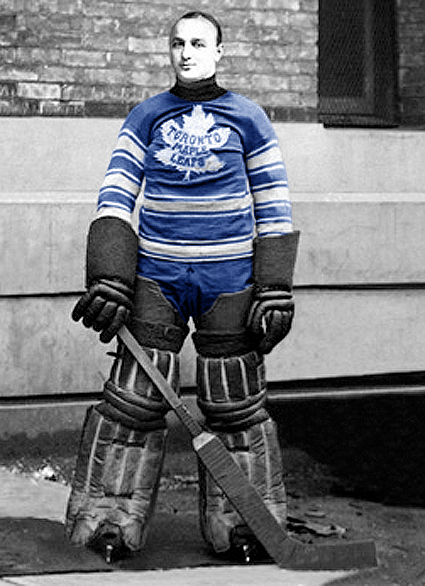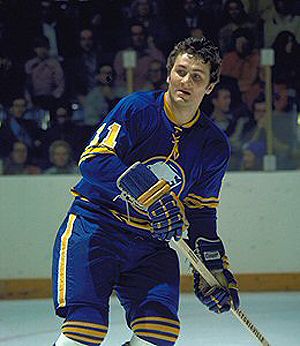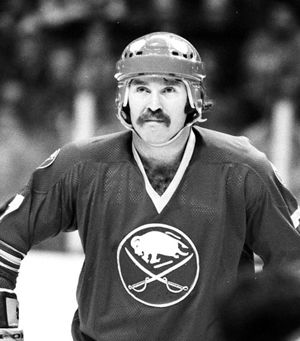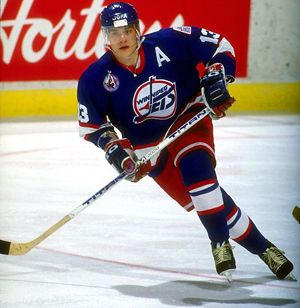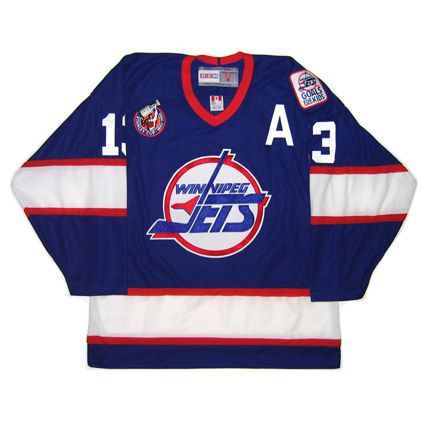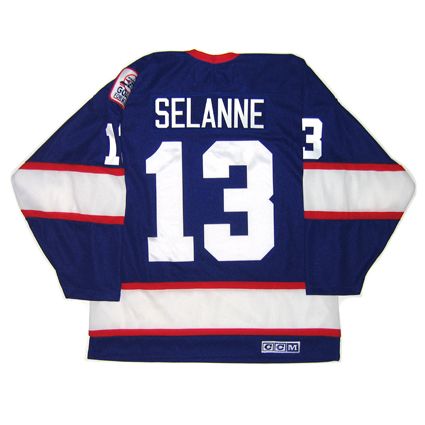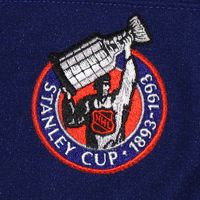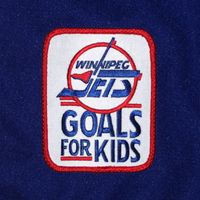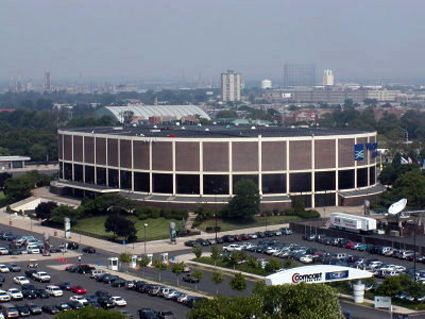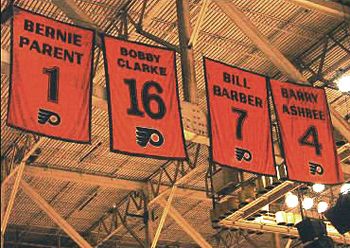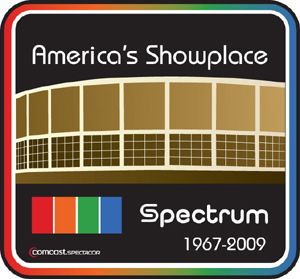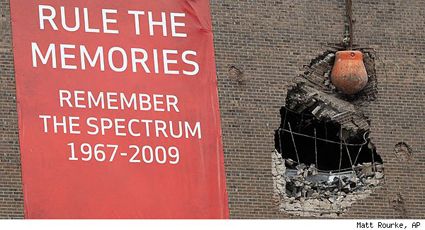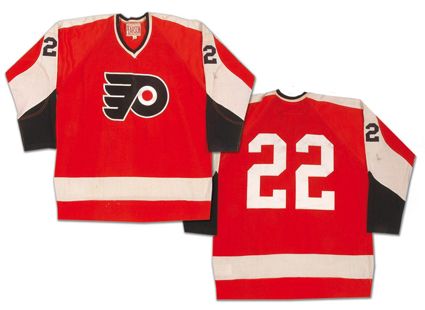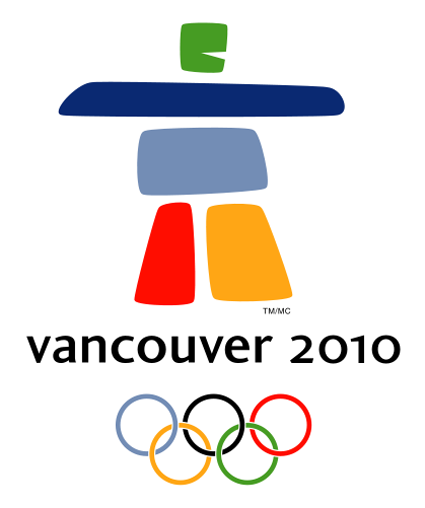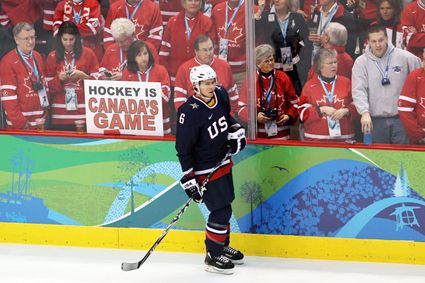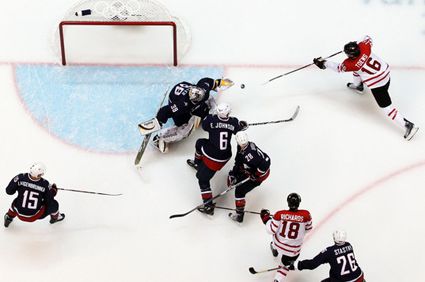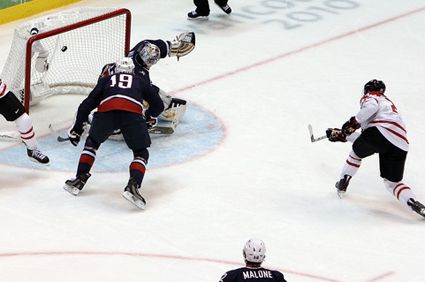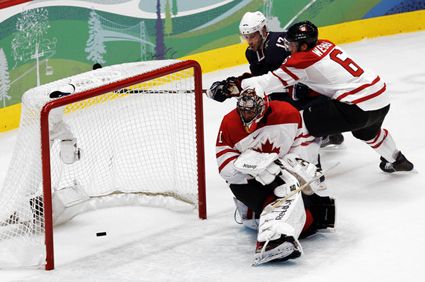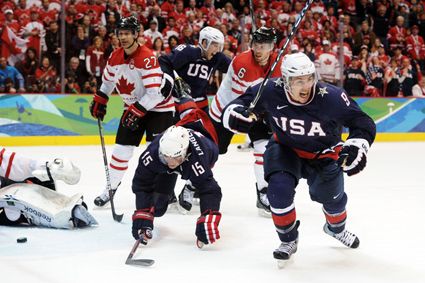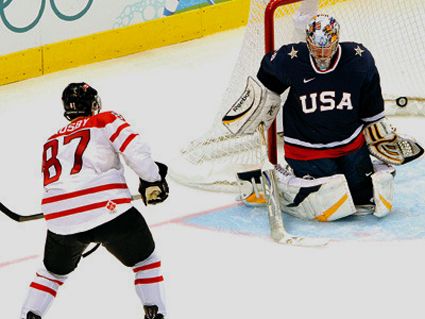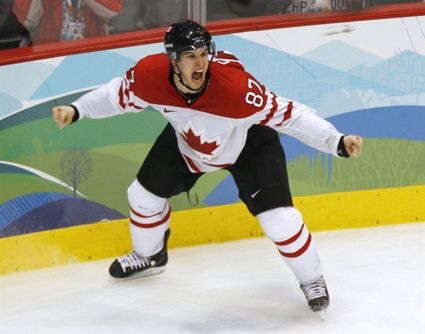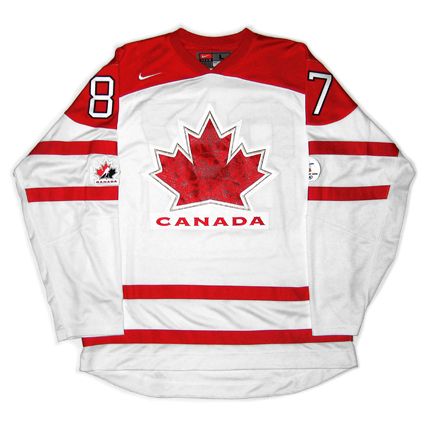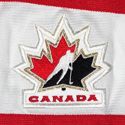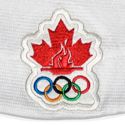Saturday, March 5, 2011
1991-92 Quebec Nordiques Mats Sundin Jersey
The 1991-92 Quebec Nordiques were looking to improve on their previous season in which they finished last overall in the NHL with a 16-50-14 record. Their 46 points were 11 less than the nest worst team, the 20th place Toronto Maple Leafs.
To that end, they selected Eric Lindros first overall in the 1991 NHL Entry Draft, despite repeated warnings from the Lindros' camp that he would refuse to play for the Nordiques due to several factors, including lack of marketing potential and having to learn to speak French if he were to play in Quebec. Standing their ground in the face of the threats from Lindros, the Nordiques chose him first overall and, as promised, he refused to report to Quebec and played for both the Oshawa Generals of the OHL and the Canadian National Team while holding out.
With their second pick, 24th overall, the Nordiques chose left wing Rene Corbet, who would play 17 total games over two seasons with Quebec, scoring just 5 total points. Round 3 saw the Nordiques select Rich Brennan, who would never even wear a Nordiques sweater during his career.
With the much publicized hold out of Lindros, and the lack of any other impact players from the draft, the Nordiques were going to be hard pressed to improve in 1991-92. The most notable additions to their roster consisted of the likes of Greg Paslawski and Russian defenseman Mikhail Tatarinov.
Still, with a top three of Joe Sakic and second year players Mats Sundin and Owen Nolan, there was some hope for increased competitiveness, but the roster had little to offer beyond those three with the exception of Russian Valeri Kamensky.
The 1991-92 Quebec Nordiques
Things got off to a deceptively bright start when the Nordiques won their opening game at home against the Hartford Whalers by a score of 4-2. They then travelled to New Jersey for their first road game of the season. Although they scored a more than respectable 5 goals, they were defeated 6-5. Two nights later they traveled to Minnesota where they lost 3-2 to the North Stars.
After a pair of home games, they lost 5-3 in Philadelphia. An overtime loss in Montreal came after a loss at home to Detroit.
Following their second win of the season at home over Winnipeg, another road loss to the Rangers followed, again by a goal. Their next three road games were all losses, at Chicago, Hartford and Boston, which came as part of a six game losing streak.
The losing streak ended with a win at home over Montreal, only to have the road losing streak extended in Montreal two nights later. After a home win over Hartford, the Nordiques earned their first point on the road in ten tries with a 4-4 tie in Buffalo. After a loss in St. Louis, their best run of form all season included two wins at home and a tie in Boston followed by another pair of wins at home for five games without a loss.
Still, their winless streak on the road continued with losses at Detroit and Washington, a tie in Calgary, a loss in San Jose and a tie at Vancouver. Two wins at home proceeded their worst run of form, with eight consecutive losses in regulation, including four in a row on the road. A win at home only momentarily broke up the losing, as their next nine games consisted of two losses, a tie and then six more losses. From January 2, 1992 and February 13th, the Nordiques would go 1-16-1, including nine more road losses and a tie to remain winless on the road since the start of the season.
Their next three games they managed a tie in Montreal, a win at home over Minnesota and another tie in Pittsburgh to begin a five game road trip. Four games later, a loss in Hartford, a tie in Montreal and losses at San Jose and Los Angeles, left them with 2 points out of a possible 10.
A tie at home against Buffalo preceded their game at Hartford against the Whalers on this date in 1992, with the Nordiques now standing 0-25-8 on the road for the season to date.
The teams ended the first period even at 3 apiece before the Nordiques erupted for five consecutive goals, which included a hat trick by Sundin. The third period saw the Nordiques again outscore Hartford 2-1 to make the final margin 10-4. It was the first win on the road for Quebec all season and their first since March 10, 1991, six days short of a year, which also came at the expense of the Whalers.
Sundin was the star of the night for the Nordiques with 5 goals and 2 assists for 7 points, becoming the 38th player in the 75 year history of the NHL to score 5 or more goals in a single game and just the third player from Sweden to accomplish the feat. His five goals alone were enough to outscore Hartford for the game.
Sundin's linemate Nolan finished the night with a goal of his own as well as 5 assists while the third member of the line, Kamensky had 2 goals and 3 assists for 5 points to give the trio 18 points during the game, including 8 of Quebec's 10 goals.
Peter Sidorkiewicz gave up the first 6 goals in 27:11 before being replaced by Kay Whitmore, who fared little better, giving up 4 goals in 32:49.
"It's a big relief," said Sundin, whose five goals broke a Quebec record held by Peter Stastny and Michel Goulet.
The Nordiques would go 6-7-2 the rest of the way, winning both ends of a home and home against Buffalo to end the season 20-48-12 with a road record of 2-30-9.
Joe Sakic would lead the club in scoring with 94 points, followed by Sundin's 76. Owen Nolan led the team in goals with 42 on his way to third in scoring with 73 to distance the top three from the rest of the squad, with no one else scoring more than 45.
The Nordiques fortunes would begin to turn around in the off-season when Lindros was finally traded to the Philadelphia Flyers in exchange for six players, a pair of first round draft picks and $15 million, which led to the Nordiques making the playoffs in 1992-93 and beginning the franchise's rise to prominence, albeit in Denver, Colorado as the Avalanche.
Sundin would play one more season for the Nordiques, his fourth, before being traded to the Toronto Maple Leafs during the summer of 1994.
Today's featured jersey is a 1991-92 Quebec Nordiques Mats Sundin jersey. The Nordiques were the last team to use heat sealed names and numbers on their jerseys prior to switching to sewn on twill numbers for the 1991-92 season, which included a switch to two color numbers, white with red trim, for the first time in their history.
This jersey features the NHL 75th Anniversary patch worn by all players in the NHL to commemorate the league's anniversary.
Today's video highlight are the Quebec Nordiques selecting Mats Sundin first overall in the 1989 NHL Entry Draft, the first European ever drafted first overall. Unfortunately for Sundin, they apparently didn't have baseball caps in Sweden at that time, resulting in the world's first stovepipe ballcap.
Labels:
Quebec Nordiques,
Sundin Mats
Friday, March 4, 2011
1998-99 Toronto Maple Leafs Mats Sundin Jersey
On this date in 1999, the Toronto Maple Leafs set an NHL record for the fewest shots taken in a winning effort with just nine shots on goal in a 4-0 win over the St. Louis Blues.
Today's featured jersey is a 1998-99 Toronto Maple Leafs Mats Sundin jersey. This attractive alternate jersey is one of the finest alternate jerseys in NHL history. It's clean, simple look is further enhanced by the lace-up collar and throwback logo, very much like the style worn from 1958 to 1967.
The Maple Leafs registered three shots on goal during the first period to ten for St. Louis, but ended the period leading 1-0 on a breakaway goal by Steve Sullivan with an assist from Mike Johnson at 11:03. Little did St. Louis know there ten shots in the first period would be more than the Maple Leafs would register for the whole game.
The second period went even better for Toronto, when Mats Sundin scored on their first shot when he beat St. Louis starting goaltender Brent Johnson with a wrist shot off Johnson's glove from the right faceoff circle.
Toronto's second shot of the period also found the back of the net when Lonny Bohonos, who had just been called up from the minors earlier that same day, fired a slapshot from the right circle, beating Johnson between his pads at 5:58, ending Johnson's day after giving up three goals on just five shots.
With Jim Carey now in goal, the Blues fared no better as Gary Valk scored for Toronto on a 2-on-1 with Igor Korolev on the first shot Carey would face, giving Toronto four goals on six shots. Carey would save the only other shot he saw in the second period, as St. Louis again outshot Toronto, this time eight to four for the period, although Toronto scored on three of the four.
Carey was able to withstand the two shot barrage he faced in the third period, but the Blues failed to score on any of the ten shots they threw at Toronto netminder Curtis Joseph, who made 28 saves while blanking his former club, the 22nd shutout of his career.
Of the nine Toronto shots, three were credited to Sundin, with no one else having more than one.
When asked about the low number of shots, Sullivan responded "As Glen Healy told me once, 'Good teams look at the scoreboard and not the shot clock.' "
This jersey also features the Memories and Dreams patch worn that year to commemorate the final season of Maple Leaf Gardens, the Maple Leafs long time home since 1931.
Today's first video is a look back at Maple Leaf Gardens.
Our next video is Hamada Takasi playing the Maple Leaf Rag on his banjo.
Labels:
Sundin,
Toronto Maple Leafs
Thursday, March 3, 2011
1927-28 Toronto Maple Leafs Joe Ironstone Jersey
Born in Montreal in 1898, Joe Ironstone grew up in northern Ontario and began his playing career with the Sudbury Wolves of the Northern Ontario Hockey League (NOHA) in the 1921-22 season, winning 3 and losing 2 in the 6 games in which he played before moving to the Sudbury Legionnaires, where he won 3 out of 3 starts during the regular season prior to going 0-1-1 in a pair of playoff games.
Back with the Wolves for 1922-23, Ironstone went 4-4 in eight games. Records show he was with the Wolves again in 1923-24, but no statistics are shown across multiple sources, perhaps indicating he did not play, perhaps due to an injury. He was signed by the powerful Ottawa Senators of the NHL in 1924-25, but saw no playing time as a backup to Alex Connell, who played in all 30 of the Senators games.
Ironstone became a member of the New York Americans during their debut season and was again a backup goaltender, this time to Jake Forbes. While Forbes played in all 36 of the games on the Americans schedule, Ironstone was able to make his NHL debut with two periods of relief work.
Having played as little as 40 minutes over the previous three seasons, Ironstone was likely more than happy to find himself a member of the Niagara Falls Cataracts (with "cataract" meaning "a large or high waterfall") where he played 23 games in the Canadian Professional Hockey League (CPHL).
He had a busy season in 1927-28, with 14 more games with Niagara Falls. After going 3-6-5, Ironstone he became a member of the Toronto Ravinas of the same league when he was sold by the Cataracts. In 26 games he posted a winning record of 13-10-3 to help the Ravinas get into the playoffs.
It was also during this season that Ironstone played in one game for the Toronto Maple Leafs against the Boston Bruins on this date in 1928 as an injury replacement for goaltender John Roach. Ironstone played well and held the Bruins off the scoreboard for the entire game, earning his only NHL shutout. He was denied the win however, when Boston's Hal Winkler matched him save for save for his 12th shutout of the season as the game ended in a scoreless tie.
The next club to employ Ironstone's services was the London Panthers, for whom he played a career high 42 games on his way to a 16-22-3 record. The 1929-30 season saw Ironstone split time between London, who switched from the CPHL to the International Hockey League (IHL). After 10 games, he was back in the CPHL with the Kitchener Flying Dutchmen, with whom he won 7 and lost 8 games.
Seemingly always on the move, the 1930-31 season was divided between the Marquette Iron Rangers of the Northern Michigan Hockey League, the Guelph Maple Leafs of the Ontario Professional Hockey League and the Syracuse Stars of the IHL.
He did not play the next two seasons, but returned to the ice with the Sudbury Legion once again for the 1933-34 and 1934-35 seasons. His final season in hockey was spent with the Falconbridge Falcons of the NOHA, with whom he completed for the Allan Cup, and also make one appearance for his original team, the Sudbury Wolves, bringing his career full circle.
Ironstone's career NHL stats are the unusual line of 0-0-1 with 1 shutout. He allowed 3 goals during his relief effort in two periods in New York, and combined with his shutout in Toronto, his final goals against average stands at 1.64.
Today's featured jersey is a 1927-28 Toronto Maple Leafs Joe Ironstone jersey from his only appearance for the Maple Leafs, which resulted in a scoreless tie.
The Toronto St. Patricks had only been renamed the Maple Leafs during the previous season when the club was purchased by Conn Smythe. At the time, they changed from the St. Pats green sweaters with a white band across the chest to a plain white sweater with a green maple leaf logo on the chest. For the 1927-28 season, the club changed colors back to blue and white, as they wore during their first two seasons while they were known as the Toronto Arenas.
The simple, stripeless white sweater, worn for games against the New York Rangers, now had a blue maple leaf crest on the front. Their primary jersey was now an attractive blue jersey with multiple arm and body stripes done in the art deco style of the times.
This exact style would remain in use three seasons until a another white stripe was added across the top of the shoulders. That version of this jersey would be used through the 1933-34 season when a reversal of course was taken and the stripes were reduced to a simple pair of narrow white stripes on the arms and waist and a new, simpler leaf crest was introduced, which is nearly identical to the one the Maple Leafs now use today, 75 years later.
Labels:
Ironstone Joe,
Toronto Maple Leafs
Wednesday, March 2, 2011
1992-93 Winnipeg Jets Teemu Selanne Jersey
During the fledgling Buffalo Sabres inaugural season of 1970-71, their first ever draft pick Gilbert Perreault scored a goal during the Sabres first ever game on October 10, 1970. He went on to lead the club in scoring that season with 38 goals and 34 assists for 72 points. Perreault's 38 goals established a new NHL rookie scoring record and earned him the 1971 Calder Trophy.
Today's video section recalls the night Selanne broke Mike Bossy's 15 year old record in front of the rabid Jets fans in Winnipeg, including his memorable celebration following the record setting goal.
Gilbert Perreault
Perreault would not hold the record long, as it would be broken the very next season by the Sabres next first round draft pick, Rick Martin. Teamed with Perreault and Rene Robert, the trio formed the explosive "French Connection" line. While Robert would not arrive until later in the season via a trade, Martin and Perreault found instant chemistry which carried throughout the entire season. With Perreault's playmaking abilities paired with a good finisher in Martin, their sats for the season were a virtual mirror image of each other, as Perreault scored 26 goals and 48 assists while Martin had an identical 74 points, but with 44 goals and 30 assists. Martin's 39th goal on February 19, 1972 broke Perreault's rookie scoring record and during the remaining 19 games, Martin raised the record to 44.
Rick Martin
Martin's record fell on February 25, 1978 when the New York Islanders first round pick in the 1977 NHL Amateur Draft, Mike Bossy, scored the 45th goal of his rookie campaign. Playing on a line with center Bryan Trottier and rugged left winger Clark Gilles, the trio finished 1-3-4 in team scoring. While Trottier led the team with 123 points, it was Bossy who benefited from Trottier's playmaking to break the rookie goal scoring record. Similar to Martin, Bossy still had 20 games remaining after breaking the record and proceeded to elevate the record up to 53, which was second in the NHL that season. Like, Perreault, Bossy was also the winner of the Calder Trophy.
Mike Bossy
Bossy's record would endure for 15 seasons, including surviving Joe Neiuwendyk's rookie total of 51 in 1987-88, until it was broken on this date in 1993 by Finnish sensation Teemu Selanne, who scored a hat trick for his his 52nd, record tying 53rd and record breaking 54th goal of the year at home against the Quebec Nordiques.
Teemu Selanne
Like those before him, Selanne was not content to simply eclipse the record, as he simply destroyed Bossy's mark of 53 as he pushed the mark into the stratosphere with a final total of 76, which tied for the league lead in goals with fourth year player Alexander Mogilny, earning Selanne a Calder Trophy like Perreault and Bossy before him.
In addition to his 76 goals, Selanne totaled 132 points to set a rookie point scoring record as well. He and Mogilny became only the second and third European players to lead the league in goals as the became members of an exclusive club of only eight men to have ever scored 70 or more goals.
Today's featured jersey is a 1992-93 Winnipeg Jets Teemu Selanne jersey. While Selanne had hoped to wear #8, it was already in use by Randy Carlyle, who would later coach Selanne in Anaheim, necessitating Selanne to wear his second choice of #13 during his rookie season. Following Carlyle's departure from Winnipeg, Selanne would switch to #8.
During the 1992-93 season, all players would wear the Stanley Cup Centennial patch on the right chest of their jerseys. Exceptions were the New York Rangers, who wore the patch on their right shoulders, and the Pittsburgh Penguins, who did not wear the patch on their new black road jerseys, both due to their diagonal cresting.
The only other oddity was that of the Winnipeg Jets. While they did wear the patch all season in the expected location, during the latter half of the season the patches worn by the Jets did not have the same bold white outline as all the other clubs.
This determination of the borderless patch being worn in the latter half of the season is corroborated by all pictures of Selanne with the assistant captain's "A", earned later in the season, being paired with the borderless patch, while early photos without the "A" have the bordered version of the patch.
The Jets would adopt a new jersey style upon entering the NHL in 1979 and wear it through 1989-90 until changing to today's featured style, which was worn through the remainder of their time in Winnipeg.
Labels:
Selanne Teemu,
Winnipeg Jets
Tuesday, March 1, 2011
1967-68 Philadelphia Flyers Forbes Kennedy Jersey
Opened on September 30, 1967, The Spectrum became home to both the expansion Philadelphia Flyers of the NHL as well as the Philadelphia 76ers of the NBA.
The Spectrum
Construction began in June of 1966 and was completed in 16 months at a cost of $7 million. The name Spectrum was chosen to represent the wide range of events that would be held there.
On October 19th, the Flyers shut out the Pittsburgh Penguins 1-0 with Bill Sutherland scoring the first goal in the building's history during their first ever home game in front of 7,812 fans.
With all six of the new expansion teams being placed in the West Division in 1967-68, the Flyers fared quite well. While all the expansion clubs were regularly defeated by the Original 6 teams which comprised the East Division, the Flyers were able to defeat all of the established clubs to gain valuable points in the standings as well as hold their own against the expansion cousins.
On February 17, 1968 the Ice Capades to move in for their show in Philadelphia. The 11,000 in attendance that afternoon got more than the bargained for when high winds blew a large section of the roof off the building with a thunderous roar, letting daylight into the arena. With the Flyers on a road trip until the 22nd, a patch was put on the roof and the Flyers completed a three game homestand without any further issues.
Going into the last of the three games on February 29th, 1968 (yes, it was a Leap Year), the Flyers were sitting at 26-24-9 with 61 points. They lost to the Los Angeles Kings 3-1 that night and then vacated the Spectrum to travel to New York to face the Rangers on March 2nd.
On this date in 1968, the winds once again blew with such force that more of the roofing was torn from the roof. Then Philadelphia Mayor James H. J. Tate surveyed the damage in person and then announced the Spectrum was closed for repairs indefinitely, forcing the Flyers to vacate the Spectrum for their remaining seven home games while repairs were conducted.
The extended time to conduct the repairs, which in reality should have taken less than two weeks was a result of the political wrangling over the situation between Republican Walter Annenberg, publisher of the Philadelphia Inquirer and Democrat Matthew McCloskey, owner of the firm who constructed the Spectrum on a limited budget due to the finances of Jerry Wolman, owner of the Philadelphia Eagles who paid for the construction of the stadium but started to run out of money before it was completed, resulting in a number of cutbacks.
More political posturing occurred between Mayor Tate, a democrat, and Arlen Specter, the city's District Attorney, and the man who Tate just happened to defeat for the Mayor's office! Specter sent his own investigators to the scene, knowing both Woman and McCloskey had contributed to Tate's campaign, looking to uncover as much evidence to use against his foes as possible.
Spectrum management, eager to get back in business as quickly as possible reminded everyone the job was rushed with everyone's knowledge in order to get the Flyers franchise. "If we'd followed every damn semicolon," said Hal Freeman, president of the Spectrum, "it would have taken three years to finish the place. Everyone knew there would be shortcuts. But we've passed every inspection required, as far as I know."
Tate, proceeding with as much care and concern as possible to keep himself from being subject to any further political scrutiny by the Inquirer, ordered the Franklin Institute to conduct tests on the new roofing materials, including some in a wind tunnel, as well as research into which kind of fasteners should be used to attach the roof. Not wanting to risk their scientific reputation, the institute took care to make an informed decision. All of this led to the extended delay in getting the roof repairs completed, sending the Flyers on the road for the final month of the season.
While the 76ers were able to simply move back to their previous home, Convention Hall, the other possibly suitable arenas in Philadelphia were not equipped to make ice back in those days. With no other options remaining in Philadelphia, the Flyers next "home" game was played in Madison Square Garden in New York City on March 3rd, (the day after the Flyers played the Rangers there) 100 miles northeast, where they tied the Oakland Seals 1-1 in front of 12,127.
The Flyers then traveled to Toronto to play the Maple Leafs on March 6th, losing 7-2, and then stayed in town to "host" Boston the next night in Maple Leaf Gardens, a game they also lost 2-1 while drawing 10,452.
A more permanent plan was put into place during the three days before their next game, as the Flyers remaining home games for the rest of the regular season were now to be played at Le Colisee in Quebec City, in Canada, which was home to the Flyers top minor league affiliate, the Quebec Aces of the American Hockey League.
Life in French speaking Canada agreed with the Flyers, as they shut out the Minnesota North Stars 2-0 behind the goaltending of Bernie Parent on March 10th with 10,171 in attendance. After defeating the North Stars again in Minnesota on March 13th, they returned "home" to Quebec to tie the Kings with just 4,116 on hand. Things were quite different when the Maple Leafs made the trip to Quebec as 13,650 were in attendance for the popular Canadian opponents, whom the Flyers defeated 7-4.
After three road games Philadelphia returned to Le Colisee for a pair of vital games as work continued on the Spectrum's roof, as the Flyers were in a tie with the Kings for first place in the division with three games left on the schedule with 71 points each.
On March 28th, the Flyers got a second period goal from Gary Dornhoefer at 4:21 and an empty net goal from Andre Lacroix to seal a 2-0 shutout by Doug Favell as watched by 5,382. The two points put Philadelphia at 73 points to the Kings 71. Two nights Pittsburgh shut out the Flyers 2-0 in Quebec, but they clinched the division with one game left to play when the Kings drew with Oakland later that day out in California during the final game on their schedule.
The Flyers dropped their final game of the season 5-1 to the Penguins in Pittsburgh to finish the season with 73 points to the Kings 72. St. Louis came third with 70 points and became the Flyers first round playoff opponent.
The two teams met at the now repaired Spectrum on April 4, 1968 for the first game in Philadelphia since February 29th. During the Flyers month long road trip in March, the club was 5-7-2 including a 3-1-1 record for games in Quebec and 3-2-2 including their relocated games in New York and Toronto.
Their playoff series went the full seven games, including wins at home in Game 2 and Game 5, but lost at home 3-1 in the deciding Game 7 to end the tumultuous finish to their season.
Throughout it's history the Spectrum saw the Flyers win the Stanley Cup at home in 1974, defeat the Soviet Central Red Army in a memorable, if not notorious, game in 1976. Later that season it also hosted to games of the inaugural Canada Cup when the United States played Czechoslovakia and the Soviet Union. It would later host Stanley Cup Finals games in 1975, 1976, 1980, 1985 and 1987.
The Flyers retired numbers hang from the Spectrum ceiling
The NHL All-Star Game was played there in both 1976 and 1992, as well as the NBA's All-Star Game in 1970 and 1976, making it the only arena's to host both All-Star Games in the same year. The NBA finals were also held there in 1977, 1980 (during the same time period the Flyers were also in the finals, 1982 and 1983.
Once the Flyers moved to a new arena, their top minor league club, the Philadelphia Phantoms called the Spectrum home from 1996 to 2009, including winning the Calder Cup in 1998 on home ice.
The jersey patch worn by the Phantoms during the Spectrum's final season
Additionally, the arena hosted the NCAA Final Four in 1976 and 1981, as well as numerous rodeos, professional wrestling cards, Concerts, including Elvis Presley, The Doors, Pink Floyd and The Who.
The Flyers continued to play in the Spectrum until the 1995-96 season until moving to the new CoreStates Center, which has since been renamed three times through various naming rights deals. After the departure of the Flyers and 76ers, the arena continued to operate as usual, which included being home to the Phantoms, as well as indoor soccer and arena football clubs.
Finally the Spectrum was closed on October 31, 2009 and demolition began in late November of 2010.
The wrecking ball begins to take down the Spectrum
Today's featured jersey is a 1967-68 Philadelphia Flyers Forbes Kennedy jersey from the Flyers inaugural season. For the Flyers first three seasons they wore simple one color numbers and no names on the backs of their sweaters. They were the first team to use orange as their primary color.
The front of their jersey was decorated with their Flying P logo, which has remained in use throughout the entire history of the team and has aged very well over time. The basic flyers sweater design of the color running down and then wrapping around the arms just above the wrists, which have always been black on both the home or road style, was a popular style at the time and the Flyers have stuck with them, although in a modified form with the introduction of the new Reebok jerseys in 2007, only to see it return in 2008 with a new retro style alternate jersey, since promoted to their primary home jersey.
Kennedy played in 603 NHL games, scoring 70 goals and 178 points as well as 988 penalty minutes. While a smaller player, he was known for his toughness and grit, making him an early fan favorite with the fans in Philadelphia.
His NHL career began in 1956 with the Chicago Black Hawks and he subsequently played for Detroit and Boston prior to joining the Flyers in 1967-68. After playing 59 games for the Flyers in 1968-69, he was traded to the Maple Leafs where his NHL career concluded.
Today's video segment begins with the Top 10 moments in Spectrum history.
Next, the Flyers win the Stanley Cup on Spectrum ice in 1974. Look at all those fans on the ice afterwards!
Labels:
Kennedy Forbes,
Philadelphia Flyers,
The Spectrum
Monday, February 28, 2011
2010 Team Canada Sidney Crosby Jersey
After their failure to medal at the 2006 Olympics, there could not have been more pressure on Canada to win gold as hosts of the 2010 Olympics in Vancouver.
The 12 teams in the tournament were divided into three groups of four teams each based on their IIHF World Rankings. Following the completion of group play, the group winners, plus the fourth ranked team, were given byes into the quarterfinals where they would await the winners of elimination games among the eight remaining teams.
Group A was won by the United States following an exciting 5-3 win for the Americans what was in doubt until the final minute before an empty net goal provided the final margin.
Hard fought Group B belonged to Russia while defending gold medalists Sweden went undefeated in Group C. Finland advanced as the fourth ranked team with 6 points in their group, the same as the Czech Republic, but earned the bye thanks to a better goal differential thanks to big wins over Belarus and Germany.
In the Elimination Round, Switzerland defeated Belarus 3-2 in overtime, the Czech Republic downed feisty Latvia 3-2, also in overtime, Slovakia beat plucky Norway 4-3 and Canada dominated Germany 8-2.
The Quarterfinals had the United States advancing with a 2-0 win over the Swiss, Finland shutout the Czechs 2-0, Slovakia upset Sweden 4-3 to end their hopes of a repeat and Canada dominated Russia 7-3.
The Semifinals paired the United States with Finland and Canada and Slovakia. In the first game, the United States streaked out to a shocking 6-0 lead a little over half way through the first period on their way to a 6-1 win and a place in the final.
Canada got two first period goals by Patrick Marleau and Brendan Morrow and then at 16:54 of the second period Ryan Getzlaf's goal gave the Canadians a 3-0 lead, which was enough to defeat the Slovaks, who scored two goals three and a half minutes apart midway through the third period to make for a tense finish. Canada was able to hold on to earn a rematch with the United States in the final with gold on the line at home and on an NHL sized ice sheet.
The dream matchup between the two North American rivals was a tense affair with both teams getting their chances to score until Jonathan Toews beat US goalie Ryan Miller on the short side to take a 1-0 lead at 12:50 of the first, the only goal of the period and the first time the United States had trailed in a game the entire tournament.
Jonathan Toews opens the scoring for Canada
The second period was more of the same, with hard hits, great saves and little scoring as the tension in the arena rose. Finally Corey Perry coming down the slot fired a loose puck past Miller for a 2-0 Canadian lead at 7:13.
Corey Perry puts Canada up by two
The Americans responded with a goal from Ryan Kesler that squeaked between Roberto Lunogo's body and arm at 12:44. The remainder of the second period was played even, as the shots on goal finished at 15-15.
Ryan Kesler's goal gets the US on the board
Again, the third period wore on as the two teams punched and counterpunched, yet both failed to yield a goal. With no penalties called, waiting for a power play proved futile. With time running out and desperation setting in, the United States pulled Miller from their goal with 1:27 remaining for an extra attacker. With time now running out on the Americans, Patrick Kane hurled the puck at the Vancouver goal. It bounced off of Lunongo and was banged in by Zach Parise with 25 seconds remaining to send the game into overtime.
Parise's late goal puts the party on hold and gives the US hope of stealing the gold
After seven minutes of play, during which many hoped someone, anyone, would score as to avoid having the gold medal decided by a shootout, Canada was leading 6-4 in shots, Jarome Iginla passed the puck off the boards to Sidney Crosby, who had a clear path to the goal. He took a few strides before shooting the puck, which went under Miller's pads before he could close the gap, ending one of the most memorable games in the history of the sport.
Crosby beats Miller to win gold
The goal sent the arena, and all of Canada, into a delirious celebration.
Crosby begins the celebration of his golden goal
The gold medal was the eighth for Canada and their second in three tries after a 50 year drought.
Canada poses for a team picture after receiving their gold medals
Today's featured jersey is a 2010 Team Canada Sidney Crosby jersey as worn during the gold medal final in which Crosby scored the gold medal winning goal in overtime. Crosby had worn the assistant captain's "A" earlier in the tournament but for the final it was worn by Iginla and Chris Pronger.
With the ruling that countries could not carry the logos of their national organizations as their main crest, the usual Hockey Canada logo was replaced by a maple leaf which contained an intricate design full of symbols of Canadian culture and heritage, including an eagle, thunderbird, moose, beaver, maple leafs representing past gold medals and fleur-de-lis as well as a hockey player.
This jersey was a big improvement over the Nike Swift jerseys introduced in 2006 where each team wore essentially the exact same jersey only with their countries colors changed. By 2010, the designs began to diverge, with each country having it's own unique designs once again, although with certain elements shared, which is natural when they all come from the same source.
This jersey is adorned with several logos, including the Vancouver 2010 Olympic logo on the left sleeve, the controversial Hockey Canada logo on the right sleeve and finally the Canadian Olympic Committee logo on the bottom right of the back of the jersey in the location formerly occupied by the IIHF logo.
Today's video selections begin with the Top 10 plays of the tournament, followed by highlights from the gold medal final.
Labels:
2010 Olympics,
Canada,
Crosby Sidney
Subscribe to:
Posts (Atom)




